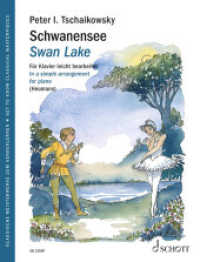- ホーム
- > 洋書
- > ドイツ書
- > Mathematics, Sciences & Technology
- > Chemistry
- > physical chemistry
Full Description
Enables readers to understand how to remove uranium from seawater and nuclear wastewater through a variety of techniques
Efficient Uranium Reduction Extraction provides experimental and theoretical knowledge on uranium reduction extraction, with information ranging from the design of extraction materials and methods to the evolution of uranium species and its reaction mechanism. Throughout the text, the authors illustrate the solution for the reductive separation of radioactive elements in complex environments and provide a new pathway for the treatment of wastewater.
Written by a team of highly qualified authors, Efficient Uranium Reduction Extraction includes information on:
General chemical properties of uranium, including its coordination structure and valence state transformations
Performance evaluation criteria and device integration for uranium reduction and extraction
Methods including nano-zero-valent iron, commercial iron powder under the influence of external fields, carbon-semiconductor hybrid materials, and plasma
Advanced techniques, such as atomic-resolved HAADF-STEM and synchrotron XAFS, which explore uranium reduction at the atomic level
Efficient Uranium Reduction Extraction delivers important and unique guidance on the subject for chemists, material scientists, and environmental scientists in universities and research institutions worldwide, along with undergraduate and postgraduate students in related programs of study.
Contents
Preface xi
1 Background of Uranium Chemistry 1
1.1 Introduction of Uranium in Nuclear Industry 1
1.1.1 Importance of Uranium Resource in Nuclear Industry 1
1.1.2 Uranium Cycle in Nuclear Industry 2
1.2 Coordination and Species of Uranium 2
1.2.1 General Chemical Properties of Uranium 2
1.2.2 Basic Uranium Species in the Solution-Uranyl and Uranyl Compound 3
1.2.3 Valence Transformation of Uranium 4
References 5
2 Introduction of Uranium Reduction Extraction 9
2.1 Introduction of Uranium Extraction 9
2.2 Introduction of Uranium Reduction Extraction 9
2.2.1 Basic Concept and Process of Uranium Reduction Extraction 9
2.2.2 Uranium Reduction by Zerovalent Iron 10
2.2.3 Photochemistry and Photochemical Uranium Reduction 10
2.2.4 Electrochemistry Involved in the Electrochemical Uranium Reduction 11
2.3 Key Factors to Influence the Uranium Reduction Extraction 11
2.3.1 Surface Adsorption and Coordination 12
2.3.2 Reductive Ability 12
2.4 Practical Situation that Requires Uranium Extraction 13
2.4.1 Uranium Extraction in Seawater 13
2.4.2 Uranium Extraction in Mining and Metallurgy 13
2.4.3 Uranium Extraction in Nuclear Wastewater 14
References 14
3 Uranium Reduction Extraction by Modified Nano Zerovalent Iron 19
3.1 Introduction of Nano Zerovalent Iron 19
3.2 Material Design for Promoted Stability and Reductive Ability 21
3.3 Uranium Extraction Performance 24
3.4 Reaction Mechanism 26
3.5 Conclusion and Future Perspectives 29
References 30
4 Uranium Reduction Extraction by Commercial Iron Powder 33
4.1 Introduction of Alternative Abundant Reductant-Commercial Iron Powder 33
4.2 Ultrasound Enhancement of Uranium Extraction by Commercial Iron Powder 34
4.2.1 Extraction of U(VI) by Commercial Iron Powder 34
4.2.2 Analysis of Uranium Enrichment Status 36
4.2.3 Key Mechanism of Ultrasonic Enhanced Commercial Iron Powder for Uranium Extraction 36
4.3 Microbial Sulfurization-Enhanced Commercial Iron Powder Extraction of Uranium 39
4.3.1 Characterizations of BS-ZVI 39
4.3.2 Performance of Photocatalytic Enrichment of U(VI) by BS-ZVI 40
4.3.3 Photoelectric Properties and Energy Band Structure of BS-ZVI 41
4.3.4 Photocatalytic Enrichment Mechanism of U(VI) 43
4.4 Conclusion and Perspectives 45
References 45
5 Photocatalytic Uranium Reduction Extraction by Carbon-Semiconductor Hybrid Material 49
5.1 Introduction of Photocatalytic Uranium Reduction Extraction 49
5.2 Motivated Material Design of Carbon-Semiconductor Hybrid Material 51
5.2.1 Introduction 51
5.2.2 Results and Discussions 52
5.2.3 Summary 57
5.3 Band Engineering of Carbon-Semiconductor Hybrid Material 57
5.3.1 Introduction 57
5.3.2 Results and Discussions 58
5.3.3 Summary 64
5.4 Assembly of Carbon-Semiconductor Hybrid Material for Facile Recycle Use 65
5.4.1 Introduction 65
5.4.2 Results and Discussions 66
5.4.3 Summary 71
5.5 Conclusion and Perspectives 72
References 73
6 Photocatalytic Uranium Reduction Extraction by Surface Reconstructed Semiconductor 77
6.1 Introduction 77
6.2 Design of Hydrogen-Incorporated Semiconductor-Hydrogen-Assist 78
6.2.1 Hydrogen-Incorporated VO 2 78
6.2.2 Hydrogen-Incorporated Oxidized WS 2 86
6.3 Hydrogen-Incorporated Vacancy Engineering 92
6.3.1 Oxygen Vacancy-Case of WO 3-x 92
6.3.2 Doping-Induced Cation Vacancy-Case of Fe-Doped TiO 2 99
6.3.3 Oxygen Vacancy Engineering in Black TiO 2 @Co 2 P S-Scheme 104
6.4 Conclusions 110
References 111
7 Enhanced Photocatalytic Uranium Reduction Extraction by Electron Enhancement 117
7.1 Introduction 117
7.2 Plasmonic Enhancement of Uranium Extraction 117
7.2.1 Enhanced Uranium by Hot Electrons of Plasmonic Metals 118
7.2.1.1 Introduction 118
7.2.1.2 Summary 125
7.2.2 Plasmonic Engineering - High-Entropy Plasmonic Alloy 125
7.2.2.1 Introduction 125
7.2.2.2 Summary 133
7.2.3 Promotion of Electron Energy by Upconversion-Case of Er Doping 133
7.2.3.1 Introduction 133
7.2.3.2 Summary 141
7.3 Enhanced by Cocatalysis 143
7.3.1 Introduction 143
7.3.1.1 Results and Discussions 145
7.3.2 Summary 156
7.4 Conclusion and Perspectives 157
References 157
8 Photocatalytic Uranium Reduction Extraction in Tributyl Phosphate-Kerosene System 169
8.1 Introduction of Tributyl Phosphate-Kerosene System-Spent Fuel Reprocessing 169
8.2 Material Design-Self Oxidation of Red Phosphorus 170
8.3 Uranium Extraction in Tributyl Phosphate-Kerosene System 173
8.4 Reaction Mechanism-Self Oxidation Cycle 177
8.5 Conclusion and Perspectives 181
References 182
9 Photocatalytic Uranium Reduction Extraction in Fluoride-Containing System 187
9.1 Introduction of Photocatalytic Uranium Reduction Extraction 187
9.2 Simultaneously Constructing U(VI) Constraint Sites and Water Oxidation Sites to Promote the Purification of Fluorine-Containing Uranium Wastewater 188
9.2.1 Introduction 188
9.2.2 Results and Discussions 189
9.2.3 Summary 197
9.3 Advanced Photocatalytic Heterojunction with Plasmon Resonance Effect for Uranium Extraction from Fluoride-Containing Uranium Wastewater 198
9.3.1 Introduction 198
9.3.2 Results and Discussions 199
9.3.3 Summary 204
References 205
10 Electrochemical Uranium Reduction Extraction: Design of Electrode Materials 211
10.1 Introduction of Electrocatalytic Uranium Reduction Extraction 211
10.2 Edge-Site Confinement for Enhanced Electrocatalytic Uranium Reduction Extraction 213
10.2.1 Introduction 213
10.2.2 Results and Discussions 214
10.2.3 Summary 219
10.3 Facet-Dependent Electrochemical Uranium Extraction in Seawater Over Fe 3 O 4 Catalysts 219
10.3.1 Introduction 219
10.3.2 Results and Discussions 220
10.3.3 Conclusion 225
10.4 Heterogeneous Interface-Enhanced Electrocatalytic Uranium Reduction Extraction 225
10.4.1 Introduction 225
10.4.2 Results and Discussions 226
10.4.3 Summary 231
10.5 Surface Hydroxyl-Enhanced Electrochemical Extraction of Uranium 232
10.5.1 Introduction 232
10.5.2 Results and Discussions 233
10.5.3 Summary 237
10.6 Charge-Separation Engineering for Electrocatalytic Uranium Reduction Extraction 238
10.6.1 Introduction 238
10.6.2 Results and Discussions 239
10.6.3 Summary 244
10.7 Conclusion and Perspectives 244
References 245
11 Electrochemical Uranium Extraction from Seawater-Reproduced Vacancy 253
11.1 Introduction of Electrocatalytic Uranium Extraction from Seawater 253
11.2 High-Selective Site Oxygen Vacancy 253
11.3 Conclusion 257
References 258
12 Electrochemical Uranium Extraction from Nuclear Wastewater of Fuel Production 263
12.1 Introduction of Nuclear Wastewater of Fuel Production: Ultrahigh Concentration of Fluoride 263
12.2 Material Design-Ion Pair Sites 264
12.3 Uranium Extraction Performance 266
12.3.1 Simulated Wastewater 266
12.3.2 Real Nuclear Wastewater 268
12.4 Reaction Mechanism - Coordination and Crystallization 268
12.5 Conclusion 270
References 270
13 Perspectives and Emerging Directions 273
13.1 Application in Real Situation 273
13.2 Criteria of Performance Evaluation 274
13.3 Device of Uranium Reduction Extraction 276
13.3.1 Chemical Reduction Coupled with External Field 276
13.3.2 Photocatalytic Device for Flow Cell 276
13.3.3 Electrocatalytic Device with Controlling System 277
References 279
Index 283








